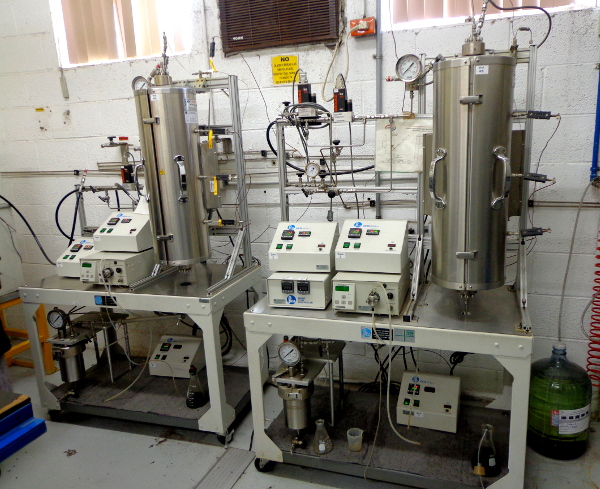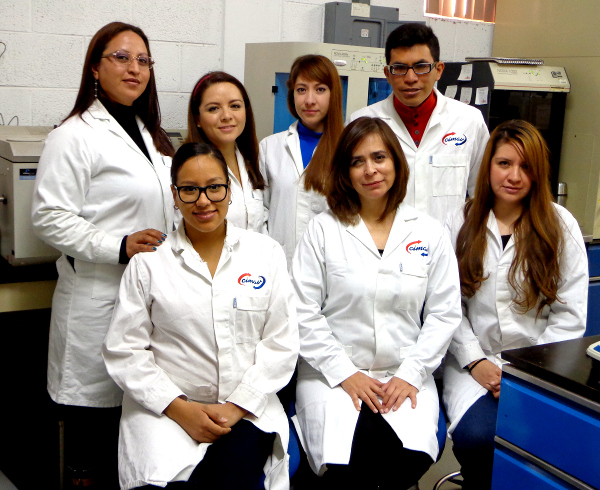Smart Surfaces

In the catalysis area of the Research Center for Advanced Materials there is a group of researchers specialized in the development of nanomaterials for different applications, which can be summarized in: catalysts for hydrocarbon hydrodesulfurization, mesoporous materials, electrocatalysts for fuel cells, aerogels and activated carbon.
Catalysts for hydrocarbon hydrodesulfurization

The increasing energetic demand along with the environmental issue has led to more rigorous regulations aimed at the reduction of sulfur contents in fossil fuels. This has motivated the research and development of agents, called catalysts, which promote the reduction of sulfur content to make them more effective.
In Cimav this group of specialists has developed catalysts for fuels with ultra-low sulfur content, under 10 PPM of sulfur. The transcendence of the catalysts developed is based on the use of nanotechnology in order to achieve high activities in materials supported on porous matrixes incorporating a low metal percentage and easily escalatable synthesis methodologies, this without a doubt represents an important technical and economical achievement for the oil industry.
One of the group’s projects has been developed under the technical specifications required by Petróleos Mexicanos, Pemex, who received the technology. One of the products of this line of research has been the registry of two national and US patents, in addition to the establishment of a unit for catalysts evaluation at the pilot level that also allows to know about the quality of the fuels obtained.
With the innovation and establishment of this pilot plant Mexico could not only avoid importing costly catalysts and evaluation services, it could also produce them for internal use and eventually when the development is completely escalated and validated, export them.
Mesoporous Materials
The development of silica-based mesoporous materials counts with several applications, such as catalyst, adsorbents and sieves (a molecular sieve is a material that contains pores of a precise and uniform size that is used as adsorbent agent for gases and liquids), among others.
The mesoporous supports obtained by this working team offer high superficial surfaces, high diameter control and distribution of the pore size. The investigation in this line allowed to have a tailored support for the application in treatments for sulfur elimination in hydrocarbons. The transfer of technology was carried out successfully in all of the country’s refineries that belong to Pemex.
Catalysts for fuel cells
Since this group of researchers has experience in synthesis of nanostructured materials, they have managed to develop catalysts to be used in fuel cells with the purpose of responding the ever increasing energy demand and the search of clean energy sources.
A fuel cell is a device used to transform energy of a chemical reaction into electricity. Among the products in this line there are at least 16 articles published as well as inter-institutional and multi-disciplinary collaborations.
Aerogels
Aerogel or solid smoke is a material constituted of more than 95% air and the rest is the same material that sand is made of, silica dioxide (SiO2). These characteristics make it an excellent support, thermal and acoustic insulator with the advantage that it does not burn, that means that in case of a fire, unlike plastic materials such as polyurethane and polystyrene, it does not produce toxic gases and it even may act as a barrier for fire propagation.
In Cimav this multidisciplinary team of researchers has developed innovative techniques for aerogel production with the aim of avoiding supercritical drying conditions (pressure and temperature in which a composite behaves as “a hybrid between a liquid and a gas”), this has been one of the limitations for intensive aerogel production. The latest progresses of the group have developed a route for obtaining dust aerogel at room pressure and temperature without modifying the aerogel’s surface.
The work carried out by this team has generated patents, publications in indexed journals with high impact, as well as inter-institutional and multidisciplinary collaborations.
Activated Carbon
The generation of activated carbon products has a great impact due to the high demand volume of this material, to be used in air and water purifying systems since it is an excellent absorbent. In Cimav this group of specialists has developed chemical and superficial modifications in order to obtain activated carbon with a higher absorption capacity and higher selectivity. They have formulated activated carbon with a high self-ignition temperature (the temperature at which it would spontaneously burn without an external heat source) through the incorporation of nanoparticles and they have also obtained activated carbon in pellets. Some of the developments of this line have already been transferred to the industry.
- Nanostructured materials
- Transition Metal Sulfide based nanostructured materials for applications in hydrocarbon hydrodesulfurization.
- Transition Metal based nanostructured materials for applications in micro and nanofluid fuel cells.
- Transition Metal Sulfide based nanostructured materials for applications in solar panels.
- Mesoporous Materials. Applications such as molecular supports, absorbents and sieves.
- Pure silica oxide aerogels and in composites tor applications such as thermal and acoustic insulators.
- Activated carbon as support for catalysts, absorbents in gas, air and water filters.
